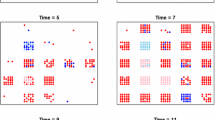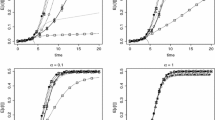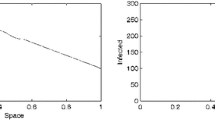Abstract
Individual-level models (ILMs) for infectious diseases, fitted in a Bayesian MCMC framework, are an intuitive and flexible class of models that can take into account population heterogeneity via various individual-level covariates. ILMs containing a geometric distance kernel to account for geographic heterogeneity provide a natural way to model the spatial spread of many diseases. However, in even only moderately large populations, the likelihood calculations required can be prohibitively time consuming. It is possible to speed up the computation via a technique which makes use a linearized distance kernel. Here we examine some methods of carrying out this linearization and compare the performances of these methods.









Similar content being viewed by others
References
Anderson, R., & May, R. (1991). Infectious diseases of humans. Oxford: Oxford University Press.
Bhadra, A., Ionides, E. L., Laneri, K., Pascual, M., Bouma, M., & Dhiman, R. C. (2011). Malaria in Northwest India: Data analysis via partially observed stochastic differential equation models driven by Levy noise. Journal of the American Statistical Association, 106, 440–451.
Brooks, S., Gelman, A., Jones, G. & Meng, X. L. (Eds.) (2011). Handbook of Markov chain Monte Carlo. London: Chapman & Hall.
Cauchemez, S., Bhattarai, A., Marchbanks, T. L., Fagan, R. P., Ostroff, S., Ferguson, N. M., Swerdlow, D., & the Pennsylvania H1N1 working group (2011). Role of social networks in shaping disease transmission during a community outbreak of 2009 H1N1 pandemic influenza. Proceedings of the National Academy of Sciences of the United States of America, 108(7), 2825–2830.
Chis-Ster, I., & Ferguson, N. M. (2007). Transmission parameters of the 2001 foot and mouth epidemic in Great Britain. PLoS ONE, 2(6).
Chis-Ster, I., & Ferguson, N. M. (2009). Epidemiological inference for partially observed epidemics: The example of the 2001 foot and mouth epidemic in Great Britain. Epidemics, 1, 21–34.
Cook, A. R., Marion, G., Butler, A., & Gibson, G. J. (2007a). Bayesian inference for the spatio-temporal invasion of alien species. Bulletin of Mathematical Biology, 69, 2005–2025.
Cook, A. R., Otten, W., Marion, G., Gibson, G. J., & Gilligan, C. A. (2007b). Estimation of multiple transmission rates for epidemics in heterogeneous populations. Proceedings of the National Academy of Sciences of the United States of America, 104(51), 20392–20397.
Daley, D. J., & Gani, J. (1999). Epidemic models: an introduction. Cambridge: Cambridge University Press.
Deardon, R., Brooks, S. P., Grenfell, B. T., Keeling, M. J., Tildesley, M. J., Savill, N. J., Shaw, D. J., & Woolhouse, M. E. J. (2010). Inference for individual-level models of infectious diseases in large populations. Statistica Sinica, 20, 239–261.
Gelman, A., Carlin, J. B., Stern, H. S., & Rubin, D. B. (2003). Bayesian data analysis. London: Chapman & Hall.
Gelman, A., Meng, X. -L., & Stern, H. (1996). Posterior predictive assessment of model fitness via realized discrepancies. Statistica Sinica, 6, 733–807.
Habibzadeh, B., & Deardon, R. (2010). The misspecification of infectious and latent periods in space-time epidemic models. Statistical Communications in Infectious Diseases, 1(2), Article 24.
Jewell, C. P., Kypraios, T., Neal, P., & Roberts, G. O. (2009). Bayesian analysis of emerging infectious diseases. Bayesian Analysis, 4(2), 191–222.
Keeling, M. J., Woolhouse, M. E. J., Shaw, D. J., Matthews, L., Chase-Topping, M., Haydon, D., Cornell, S. J., Kappey, J., Wilesmith, J., & Grenfell, B. (2001). Dynamics of UK foot-and-mouth epidemic: stochastic dispersal in a heterogeneous landscape. Science, 294, 813–817.
McBryde, E., Gibson, G., Pettitt, A., Zhang, Y., Zhao, B., & McElwain, D. (2006). Bayesian modeling of an epidemic of severe acute respiratory syndrome. Bulletin of Mathematical Biology, 68, 889–917.
McKinley, T. J., Cook, A., & Deardon, R. (2009). Inference for epidemic models without likelihoods. International Journal of Biostatistics, 5(1), Article 24.
Müller, P., & Quintana, F. A. (2004). Nonparametric Bayesian data analysis. Statistical Science, 19, 95–110.
O’Neill, P. D. (2010). Introduction and snapshot review: relating infectious disease transmission models to data. Statistics in Medicine, 29(20), 2069–2077.
Tildesley, M. J., Savill, N. J., Shaw, D. J., Deardon, R., Brooks, S. P., Woolhouse, M. E. J., Grenfell, B. T., & Keeling, M. J. (2006). Optimal reactive vaccination strategies for an outbreak of foot-and-mouth disease in Great Britain. Nature, 440, 83–86.
Toni, T., Welch, D., Strelkowa, N., Ipsen, A., & Strumpf, M. P. (2009). Approximate Bayesian computation scheme for parameter inference and model selection in dynamical systems. Journal of the Royal Society Interface, 6, 187–202.
Vrbik, I., Deardon, R., Feng, Z., Gardner, A., & Braun, W. J. (2012). Modeling the spatio-temporal dynamics of combustion. To appear in Bayesian Analysis (available online March 2012).
Zelner, J. L., King, A. A., Moe, C. L., & Eisenberg, J. N. S. (2010). How infections propagate after point-source outbreaks: an analysis of secondary norovirus transmission. Epidemiology, 21, 711–718.
Acknowledgements
This work was funded by the Ontario Ministry of Agriculture, Food and Rural Affairs (OMAFRA)/University of Guelph partnership and the Natural Sciences and Engineering Research Council (NSERC) of Canada Discovery Grants Program. This work was also made possible through the use of computing facilities funded in part by the Canada Foundation for Innovation (CFI) and NSERC. We would also like to thank the reviewers of the paper whose revisions on an earlier draft have helped substantially improve the paper.
Author information
Authors and Affiliations
Corresponding author
Rights and permissions
About this article
Cite this article
Kwong, G.P.S., Deardon, R. Linearized Forms of Individual-Level Models for Large-Scale Spatial Infectious Disease Systems. Bull Math Biol 74, 1912–1937 (2012). https://doi.org/10.1007/s11538-012-9739-8
Received:
Accepted:
Published:
Issue Date:
DOI: https://doi.org/10.1007/s11538-012-9739-8




